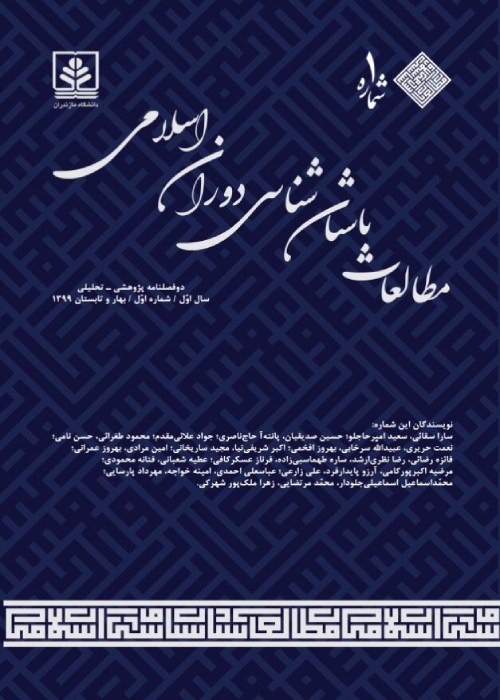A Numismatic Study on the Reign of Ishaq Ibn Ahmad Samani (301 AH) in Samarqand
With the vacuum created after the assassination of Ahmad ibn Ismail in the month of Jumada al-Thaniin 301 AH, dual fronts were formed to gain the Emirate: the Bukhara Front and the appointment of the eight-year-old son of Ahmad, Nasr, and the Samarqand Front The elder of the Samani family, brother of Amir Ismail (295-279 AH), Ishaq Ibn Ahmad; Eventually, this dispute ended in favor of Amir Nasr with the victory of Bukhara over Samarkand. Since Isaac ruled the emirate for a short time, he minted dinars and dirhams (Samarkand struck in 301 AH); So look for these coins in numismatic sources to find more information on this subject. Due to the fact that history books provide scattered and different information, especially the time of this event, these coins, which were struck at the height of the chaos, It can be placed as a valuable document alongside other books and archaeological data and shed light on some of the dark points of the history of this period. Therefore, the central issue of this research, in addition to introducing these important coins, is to reconstruct and determine the causes of some events in this period. This research raises two main questions: 1. How can the events of that era be reconstructed using the coins of Amir Ishaq (Samarqand dirhams and dinars minted in 301 AH)? 2. Why is the mention of the Abbasid Caliph coined on these coins and what effect did it have on the legal legitimacy of Ishaq Emirate?
the main basis of this article is coin data, especially two important coins of Amir Ishaq, which date back to 301 AH. They were built in the city of Samarqand. In this research, perceptual archeological approaches and historical approach were used to examine the ancient data, ie coins. Perceptual archeology is the study of the way of thinking in the past, which discovers mental products through the remnants of the past. The historical approach is the reconstruction of the human past based on the critical analysis of historical texts, which is finally evaluated with archaeological data and provides the final analysis. In fact, the use of perceptual archeology and historical approach in the Samanid era, which has left both material evidence and historical texts, can be the main and appropriate basis.
Initially, the purpose of creating coins was to facilitate exchanges and trade, but after a short time, coins became a symbol of ethnicity, sovereignty, independence, etc .; The Samanid Emirate and other contemporary Islamic emirates were not outside the scope of this argument; But it goes without saying that at that time, the permission of the Caliph of Baghdad was a prerequisite for minting coins. Each of the emirate's claimants presented letters to the caliph demanding the legitimacy of their emirate. Although the Caliph of Baghdad may have a positive and reciprocal view of either, he most likely first had a positive view of Isaac and affirmed his rule, because according to up-to-date historical texts The first of Muharram in the year 302 AH. It was reported that Nasr overcame Ishaq and took him captive, so the caliph sent a disgrace and a brigade to Nasr; Another example is that Ishaq in the second half of 301 AH. He started minting all kinds of coins in Samarqand (coins discussed in the article) and his son Mansur, who had the Emirate of Nishabur, minted dinars in Nishabur in support of his father; But Nasr struck coins only when Ishaq and his army were killed at the end of 301 AH. They had defeated and opened Samarqand. Eventually, Ishaq ibn Ahmad was captured and taken to Bukhara, until finally in the month of Safar in 302 AH. He died in Bukhara prison.
With the assassination of Ahmad ibn Ismail, two confrontations arose between Amir Ishaq in Samarqand and the supporters of Amir Nasr in Bukhara to seize power in the Samanid Emirate, and widespread unrest spread throughout the Samanid realm; Eventually, Samarqand's troops were defeated in this war, Ishaq was arrested and settled in Bukhara prison, and finally Amir Bukhara, Nasr became emir of all the lands of the Samani Emirate. Unfortunately, historical texts have provided different and scattered information about this, so the discovery and introduction of significant coins, also belonging to this time, was able to reduce the unknowns and provide a more coherent view to researchers. These two coins represent the dinars and dirhams of it by Ishaq Ibn Ahmad Samani, who died on the Samarqand front in 301 AH. Have been multiplied. But the main knot that was untied by these coins was the question of the legitimacy of the parties by the Abbasid Caliphate; Although the Caliph of Baghdad could have had a positive and reciprocal view of each of these claimants, it is almost certain that the Caliph initially preferred Isaac and affirmed his rule, because Isaac in The second half of the year 301 AH. In the most important cities of his influence (Samarqand and Nishabur), he minted all kinds of coins in his own name and the caliph of the time, Al-Muqtadir, while the most important purpose of minting coins in that era was to show the power of the coin owner. Has been in the area; However, history did not mention a coin called Nasr in Bukhara, and after the defeat of Isaac at the end of 301 AH. In Samarqand, dinars and dirhams were minted in his name.
There is no funding support Authors' contribution … Conflict of interest Authors declared no conflict of interest Acknowledgments …
- حق عضویت دریافتی صرف حمایت از نشریات عضو و نگهداری، تکمیل و توسعه مگیران میشود.
- پرداخت حق اشتراک و دانلود مقالات اجازه بازنشر آن در سایر رسانههای چاپی و دیجیتال را به کاربر نمیدهد.



